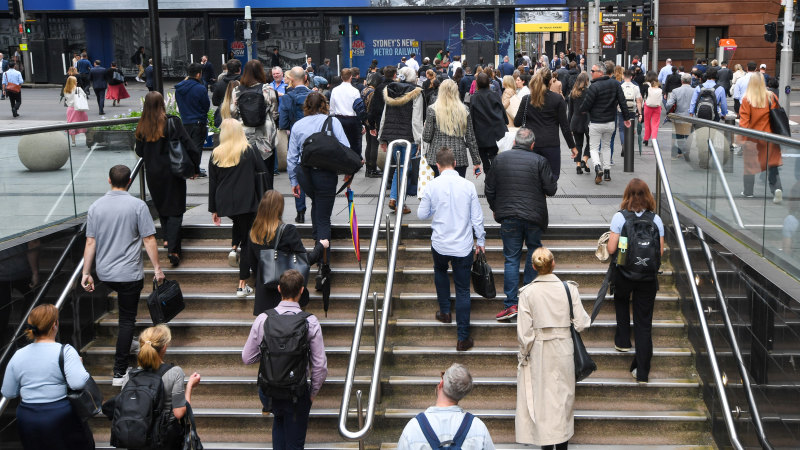“By and large, they’re saying they don’t want to return to the office, and they enjoy the flexibility,” Zhao said. “Even in the reviews that are more neutral or mixed, they’re talking about how RTO has been rocky.”
Quiet quitting
Quiet quitting is a new term for an old idea, that of employee disengagement.
It’s a bit of a misnomer because quiet quitters aren’t walking away from their jobs. Instead, they’re renouncing hustle culture, quitting “the idea of going above and beyond at work,” as TikTok user zaidleppelin said in a July post that helped popularise the phrase. The trend has resonated strongly with Gen Z and millennial workers fighting to rewrite the rules of the workplace.
Some workers define it as doing the bare minimum. Others frame it as setting reasonable boundaries and saying no to staying late or being endlessly reachable on email or Slack.
One of the most critical factors in quiet quitting is whether employees feel like they have good work-life balance, according to Benjamin Granger, chief workplace psychologist at Qualtrics, a survey-software provider. Employees who say they feel overloaded are more likely to put up boundaries and say, “I’m going to take my foot off the gas,” Granger said.
Loading
Whatever the definition, the goal is the same: untangling employees’ identities from their jobs and leaving them with more time and energy to invest elsewhere.
Productivity paranoia
As hybrid work became the norm, and bosses found themselves under increasing pressure to boost performance with a possible recession threatening the economy, there’s been a steady flow of executives such as Google’s Sundar Pichai and Meta’s Mark Zuckerberg pledging to boost productivity, calling out low performers and asking their workers to do more.
They had some reason to worry: In the first half of 2022, productivity plunged by the sharpest rate on record going back to 1947, according to data from the US Bureau of Labor Statistics.
The plunge was perplexing to some because productivity took off to levels not seen in decades when the coronavirus forced an overnight switch to remote work, leading some economists to suggest that the pandemic might spark longer-term growth. The opposite happened.
Microsoft chief executive Satya Nadella said his company coined the term “productivity paranoia” to describe employers’ anxieties about whether their employees are working hard enough, especially when they’re out of the office.
“When we talk to leaders, they’re missing the old cues, the visibility of being able to walk down the hall and check in on people and see and understand what they’re working on,” said Colette Stallbaumer, general manager of Microsoft 365 and the company’s future of work efforts.
Productivity paranoia can breed bad behaviour among bosses, Stallbaumer said, whether it’s the introduction of workplace surveillance tools or pushing stringent back-to-office policies that leave employees feeling alienated.
Boomerang employees
As the pandemic led employees to reconsider how work fits into their lives, the strength of the labour market gave workers leverage to pursue new options. In the US, roughly 48 million workers left their jobs in 2021, in what became known as the Great Resignation.
But some workers left positions only to discover that the grass isn’t always greener on the other side. In the past, some employers were reluctant to rehire workers that left for other opportunities, but this time, the tight labour market has prompted companies to rethink things.
Boomerang employees, as they’re called, have been a key resource for firms amid the war for talent: They require minimal training and get back up to speed quickly.
Boomerang employees made up nearly a third of hires from outside a company from January 2019 to April 2022, according to data from Visier, a workforce analytics company. The average returning employee was rehired within about 13 months. And boomerang employees earn 25 per cent more, on average, upon return than they did when they resigned.
Career cushioning
As recession fears began to grow toward the end of the year, layoff announcements rippled through the tech industry and beyond, with companies such as Facebook’s parent Meta, Snap and Goldman Sachs slashing thousands of positions. Employment experts say it could be a sign the pendulum of power is swinging back toward employers heading into 2023.
Loading
With storm clouds gathering in the labour market, employees are keeping their options open. Enter “career cushioning,” which borrows some terminology from the dating sphere, where “cushioning” describes someone who’s exploring a plan B in case their relationship doesn’t work out.
Career cushioning can mean preparing for a possible change by beefing up skills or networking, or it can mean actively pursuing other opportunities. The phrase has gained popularity on social media and among HR professionals as a wave of employees and would-be job seekers prepare for more disruption.
As the labour market has cooled slightly, LinkedIn has seen evidence that workers are bracing “for whatever headwinds are next in the economy,” according to Blair Heitmann, a career expert with the job platform. Some people are working longer hours, thinking about taking a second job or looking for more stable opportunities.
“Our data is showing us that more people are looking for jobs, that people are getting prepared,” Heitmann said. “It’s a bit of a mind-set shift when you juxtapose that with the last few years. The power paradigm is shifting a bit.”
The Washington Post
Stay connected with us on social media platform for instant update click here to join our Twitter, & Facebook
We are now on Telegram. Click here to join our channel (@TechiUpdate) and stay updated with the latest Technology headlines.
For all the latest Business News Click Here
For the latest news and updates, follow us on Google News.

